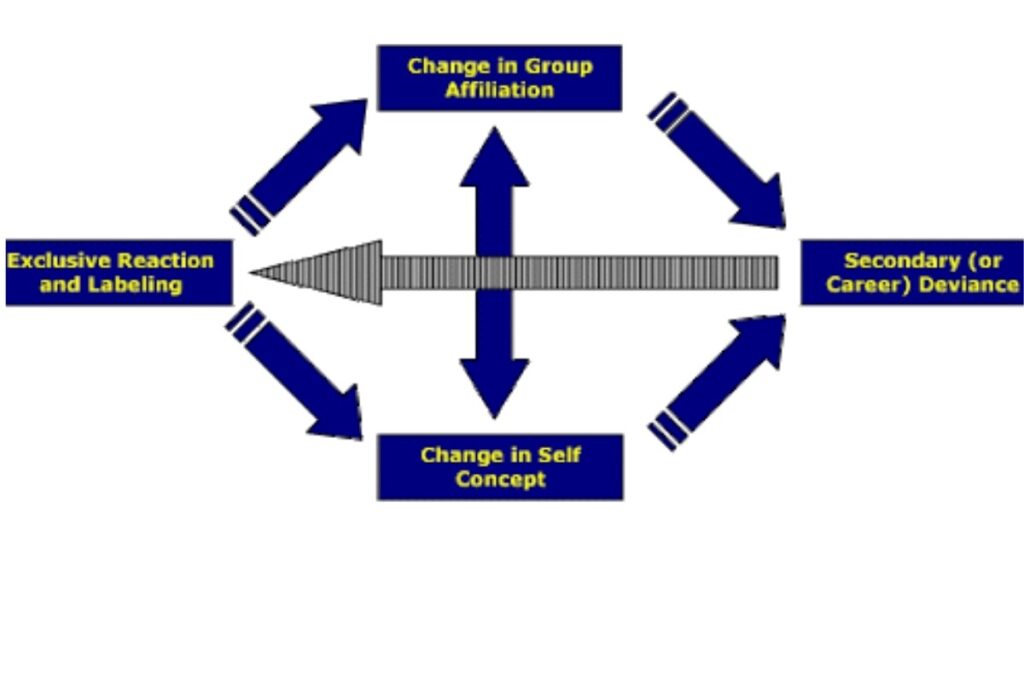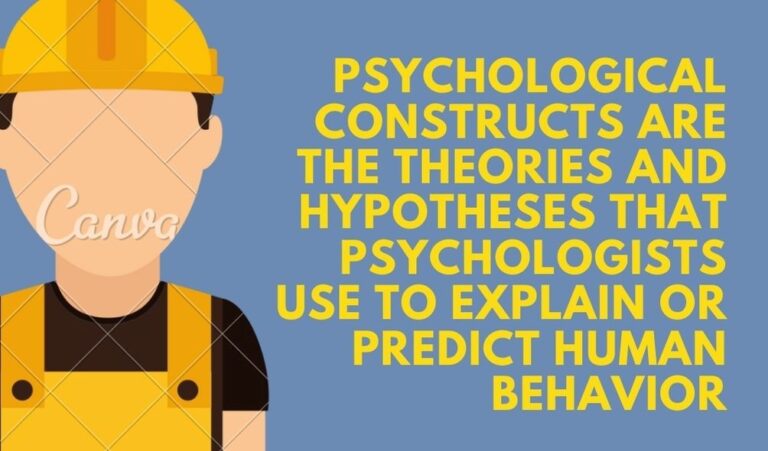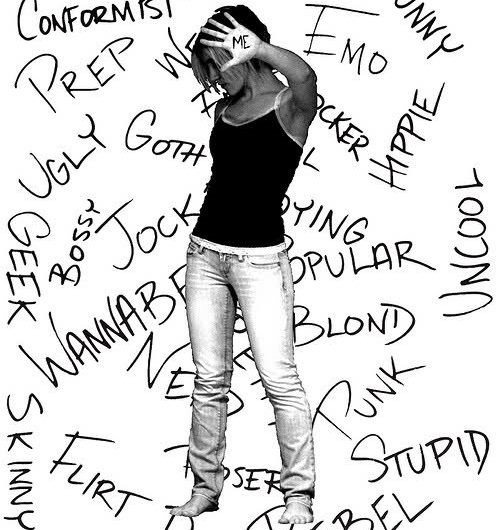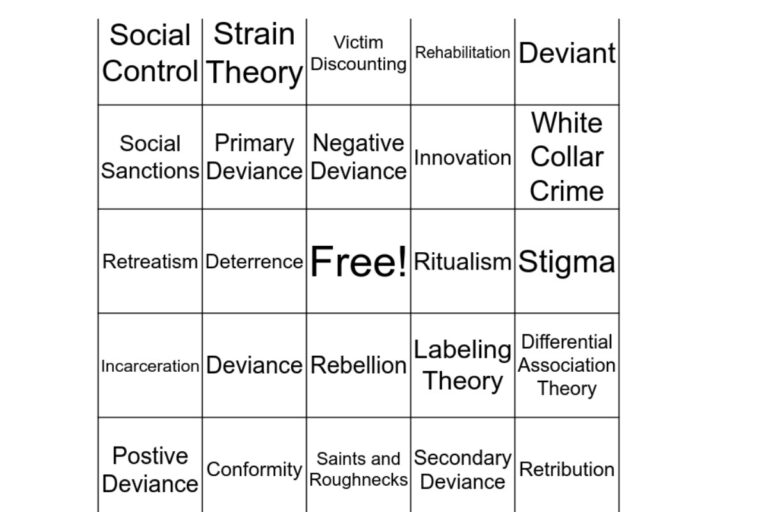Theories of Crime in Sociology- Explanations and Examples
Introduction
Theories of crime are based on influences and conditions that steer people toward criminal or deviant actions. There are many crime theories, but no one theory can explain all the causes of crime.
Crime theories give different kinds of explanations about why and how criminals commit their crimes. Some of these explanations suggest that criminals have internal problems like mental illness or personality disorders. Others believe that criminals are influenced by external factors such as poverty, discrimination, or poor parenting.
There are different crime theories: control theory, strain theory, social meaning theory, conflict theory, social disorganization theory, labelling theory, anomie theory, and differentiation association theory.
Control Theory
The control theory suggests that humans have a natural tendency towards crime. People who are less likely to commit crimes are usually those who can control their behavior and emotions.
The ability to control one’s behavior is linked to the violation of societal norms and laws. The control theory states that those who are likely to engage in criminal and deviant behavior lack self-control.
This theory suggests that the best way to prevent crime is by teaching people how to control their behavior. Radzinowicz identified three types of control theories:
Classical Control Theory (Theory created by Beccaria)
This theory assumes that people have control of their feelings and desires. This assumption is built on the principle of free will. Beccaria believed that people could choose to commit crimes or not.
According to Beccaria, most people do not become criminals because they have the self-control to resist the temptation of committing a crime.
Beccaria argued that it is essential to prevent people from doing wrong and affecting others. He also believed in punishment to prevent crime because by punishing a person who has done something wrong, the chance of that person doing wrong again is low.
Positivist Control Theory (Theory developed by Lombroso)
This theory assumes that people do not have control of their feelings and desires. This assumption changed when Lombroso discovered a few things about deviant people. Some of them were born with character traits, such as a low forehead or extra digits.
Lombroso suggested that people born with disabilities or defects are more likely to turn to crime based on his findings. The positivist control theory also associates high crime rates with people living in poverty.
Economic difficulties force people to think the only way to survive is by resorting to crime. The positive control theory believes that crime rates can be reduced. This decrease can be achieved by increasing public awareness, public education programs, and community action.
Liberal Control Theory
It suggests that an individual’s moral standards should be the most effective way of preventing crime.
This theory is similar to the positivist control theory but thinks that education and awareness are more effective than using punishment as a form of control.
According to the liberal posse theory, a person’s ability to resist crime is enhanced by having moral values, self-confidence, and a strong internal moral code.
You may also want to check primary theories of crime causation
Strain Theory


Robert Merton developed this theory in the 1930s. Merton believed that people who are financially stable and have fulfilling jobs do not tend to commit crimes.
Financially unstable people have a high chance of committing crimes because they can not fulfil their basic needs. He believed that people would turn to crime if they were not able to achieve the American dream.
Merton suggested that people are more likely to become criminals because society and institutions do not encourage them but instead discourages them from fulfilling their dreams.
Some people who grow up in poor neighborhoods do not receive the same opportunities as the rich. This means the poor neighborhood does not have programs, such as free libraries, to encourage people to achieve their dreams.
Features of the strain theory include
- The opportunity to commit crime-life is not fair.
- Ability to commit crime-people who are students of crime can carry out the crime
- Motivation to commit crime-poor neighborhoods do not have access to opportunities such as education, which often leads to crime.
Factors that influence The Strain Theory
- Low self-esteem
- High unemployment levels
- A lack of education and training opportunities
- Lack of role models
- Community poverty
You may also be interested in sociology paradigms
Social Disorganization Theory (Developed by Shaw and McKay 1925)


This theory puts social disorganization at the Centre of crime in society.
In 1925, the social disorganization theory was introduced by two sociologists, Robert Shaw and Louis W. McKay. They used the poor neighborhood of Montreal, Canada, as a test area to research this theory.
In the area of Montreal that they were studying, there was a high crime rate. What was interesting about this area is that the crime rate increased after a neighbourhood became poorer. Also, more crimes were registered when more black people started to move in.
The social disorganization theory explores how people’s inner-city neighborhoods become a breeding ground for crime and criminal activity. The poor neighbourhoods where there is a lot of crime are known as concentrated areas of poverty.
This theory says that when people move to a neighborhood already at a high crime rate, the crime rate will increase. It focuses on the idea that higher crime rates result from poverty and low education levels.
Principles of the Social Disorganization Theory
The social disorganization theory believes that as people move into high crime areas, the following things happen:
- There is a loss of family structure.
- The education level of the community decreases, leading to people being less productive and successful in society.
- There is increased criminal activity.
- There is an increase in the number of people living in these neighbourhoods, as more and more people are attracted to the high crime rate.
Assumptions of the Social Disorganization Theory
The social disorganization theory uses the following assumptions:
- A high concentration of poverty will breed crime.
- Crime and low education levels go together.
- People tend to stick with what they know, and if they are poor, this means that they will remain poverty-stricken and, therefore, be more likely to become criminals.
Criticism
- The social disorganization theory can explain why crime occurs in poor neighbourhoods, but it cannot explain all types of crime.
- This theory does not explain why people commit certain types of crimes more than others. For example, it cannot explain why sexual crime is mostly committed by men, not women.
- The social disorganization theory fails to clarify why people in poor neighborhoods do not always turn to crime as a way of making money to support themselves.
Classical Theory
The classical theory states that people are born with different personality traits; some will become criminals because of their personality type, while others will not.
This theory explores how some people are born with personalities that make them more likely to commit crimes. It focuses on the part of a person’s personality that determines whether they are likely to be violent or not.
The classical theory does not mean that bad people are born but that some people have a personality that may make them more likely to commit a crime. It suggests that these personalities are:
- Psychopathic personality type
- Defective personality types like sexual deviancy or kleptomania; which are personality types that make people more likely to commit a crime.
As noted, the classical theory states that people are born with different personalities; some will become criminals because of their personality type, while others will not. It believes that crime is a result of being born with an aggressive or antisocial personality.
Assumptions of the Classical Theory
The classical theory uses the following assumptions:
- The primary cause of crime is the personality structure of an individual.
- Individual behaviour cannot be predicted because it is impossible to know how a person with an aggressive personality will react in any given situation.
- People are born with a range of very different personalities, and that no one type is better or worse than any other.
- Individuals do not have control over how they behave.
Criticisms of the Classical Theory
- The classical theory has many criticisms, but perhaps the most important is that it cannot explain all types of crime.
- The theory does not acknowledge that the social environment could have any impact on a person’s personality. It cannot explain why some people may be more likely to commit crimes because of their environment than others; for example, why do men commit most crimes?
- While a man with an aggressive personality may be more likely to commit sexual violence than a woman, a man who grows up in poverty may be more likely to commit burglary than someone who does not have such an experience. In classical theory, this is not possible. They do not believe that social deprivation can have any influence on a person.
- The classical theory fails to explain why all people with aggressive personalities do not commit a crime.
- Classical theory is an outdated explanation of crime that cannot explain why people commit crimes. This is because it does not consider the social environment in which many people grow up.
You may also check biosocial theories
Rational Choice Theory


The rational choice theory was developed by an American criminal sociologist, Robert Agnew, in 2001. It states that crime is a rational choice for people, and as such, there is no need to look at the personality of criminals.
This theory states that criminal behaviour is a rational way of achieving particular aims. For example, if you are poor and desperately want money-and do not have the means to earn it legally-you may steal.
The rational choice theory does not look at why people commit crimes but instead looks at the rational choice for someone who wants to commit a crime and what they will do about it.
Assumptions of the Rational Choice Theory
The rational choice theory makes several assumptions:
- Criminals make rational choices when they decide to commit a crime.
- Deviant individuals can weigh up the risks and benefits of their choices.
- Criminals only commit crimes for one of two reasons: either to obtain something they want or because of ego.
- Lawbreakers will make rational decisions about whether or not to go on to offend. If the costs of committing a crime outweigh the benefits, then they will not offend.
You may also be interested in symbolic interactionalism
Criticisms of the Rational Choice Theory
The rational choice theory is criticized for several reasons:
- This theory is based on the assumption that criminals make rational choices. However, this may not be true. For example, people who commit crimes out of passion are not always reasoning.
- Some crime types, such as white-collar crime and corporate crime, are improbable to be committed by individuals; these crimes require a certain amount of organization hence the irrationality.
- Further criticisms come from the fact that the theory assumes that all crimes are committed for either material or egoistic reasons. This theory also states that people only commit crimes if they expect some gratification.
However, there are many other reasons people commit crimes: they may have a mental illness, want to create fear, or have been manipulated by others.
You may also be interested in Thomas theorem
Social Learning Theory


This theory suggests that people learn their violent and criminal behaviour through observation. It is also known as observational learning. American psychologist Albert Bandura developed it in 1961.
People who learn violent behaviour through observational learning are known as agents or models. The theory suggests that if someone sees another person committing a crime, they are more likely to imitate this behaviour.
In summary, in this theory, Albert Bandura argues that deviant members of a community can influence the behaviour of others in that community. Therefore, a person who sees others committing crimes will be more likely to commit similar criminal acts.
You may also want to check interactional perspective
Assumptions of the Social Learning Theory
- People are likely to learn violent behaviour that is rewarded or reinforced by positive consequences. This means only the behaviours that bring pleasure and reward are likely to be repeated.
- An individual will pick up deviant behaviour that is not punished not reinforced by negative consequences. This means when a person is punished for their actions, then they will not repeat that behaviour in the future.
- People learn criminal behaviour by watching others. If a person learns this behaviour through others then they will be more likely to commit the crime themselves.
Social learning theory has been criticized, and some of the limitations are;
- It is possible for an individual to copy the deviant behaviour of another person and not learn it. They could copy because they wanted to or were having fun.
- If a person has formed strong bonds with their family, they will be less likely to pick up the deviant behaviour of others. This is because they will want to behave in a certain way to please their family, which has more impact than the behaviour of others.
- Social learning theory cannot explain why a person would choose to imitate the deviant behaviour of strangers.
- This theory doesn’t clarify why a person would choose to imitate a more serious crime such as murder or rape rather than simple ones.
You may also check Sick Role Theory
Labelling Theory


In the 1960s, sociologist Howard Becker developed this theory. He said that criminal behaviour is a label or status that society attaches to an individual. In other words, the label is a status that society evaluates an individual with based on their behaviour.
The idea behind labelling theory is that criminal behaviour is a result of social reaction. Becker believed that the punishment an individual receives might become internalized, which can lead to further criminal behaviour.
Becker argued that the labelling process could be divided into three stages:
- The deviant behaviour is committed, and the individual is identified as a deviant.
- A social reaction occurs. People in society reject the behaviour, and the individual ceases their deviant behaviour.
- Society treats this person as a criminal. This is how people in society view criminal behaviour as it affects the identity of an individual.
Once society labels someone a criminal, that person becomes a deviant, and the deviant behaviour becomes the person’s new identity.
Criticism
- One of the criticisms of Becker’s labelling theory is that it cannot explain why some people do not respond to a label. For example, if someone is labelled as a criminal and does not care, what makes them go back to crime?
- Another criticism is that this theory cannot suggest why some people are more likely to respond to a label than others.
- Labelling theory assumes that society views deviance as unfavourable, and the attempt to change the behaviour of an individual is unlikely to be successful.
- Albert Bandura argued that deviant community members could influence someone to be deviant, depending on how much they want to conform. An example of this is the Stockholm syndrome. This occurs when a victim identifies with the perpetrator of a crime.
You may also be interested in self fulfilling prophecies
Anomie Theory
It is one of the popular sociological theories about criminal behaviour. It was developed by Emile Durkheim in the late nineteenth century and suggested that anomie refers to the breakdown of social norms and values in society.
A typical example of this is what happened during the 1960s with the increase in drug use. Anomie theory suggests that social disorganization is likely to occur in times of rapid change and uncertainty.
Anomie theory explains how patterns in society can be explained by the equilibrium between the moral regulation of individuals and the processes that place pressure on individuals to violate those norms.
If there is too much control, then people will be forced into conformity. By doing so, it may result in deviant behaviour because they would feel stifled by social control. There would be little chance of satisfying their needs hence a negative societal response.
Again, if there are too many possibilities, people may wonder what the correct way to behave is. This uncertainty can prompt them to seek guidance elsewhere.
Anomie may lead to criminal behaviour because the rules and norms of society have been broken down. Also, people do not feel that society effectively deals with the breakdown in social norms and values.
The Main Features of the Anomie Theory :
- There is a breakdown of social norms and values as society becomes less cohesive. This breakdown results in uncertainty over the rules of behaviour.
- Society cannot effectively deal with the breakdown in social norms and values, and the individual views this breakdown as a rejection of their lifestyle.
- Society’s inability to effectively deal with the breakdown in social norms and values may lead to an individual feeling “alienated” from society, which may prompt criminal behaviour.
You may also be interested in moral panic examples and stages
Conflict Theory


Unlike other theories, conflict theory does not focus on individual characteristics. Instead, it focuses on broader social factors that may influence crime. This theory suggests that society is divided into two main groups, the wealthy and the poor.
According to the conflict theory, the wealthy members of the society are associated with power. They have control, and therefore there is little chance for the poor people to organize a rebellion against them.
The theory suggests that because the poor remain fatalistic, they may turn to deviant behaviour. This deviance is done in the hope of gaining recognition from the wealthy or at least becoming conscious of their plight.
The poor people’s rebellion can be expressed by breaking the law, and the media plays a vital role. The media will primarily focus on the wealthy and their lifestyles. Consequently, the poor people feel that they are being ignored.
The Main Areas of Conflict Between the Poor and the Wealthy
- The poor feel their needs as deviants are not being met, and they are mistreated. They see the wealthy as people who have gained success through exploiting them, which can cause resentment.
- The wealthy may act as gatekeepers. This suggests that they have the power to decide who gains access to social resources and status.
- Poor people may believe the wealthy are hypocrites because they profess high moral values but live in decadence.
- Poor people may believe they need to break the law to get the attention of the wealthy.
- The wealthy may be seen as the oppressors because they deny poor people access to resources, which are required for survival.
- There is a lack of opportunity for the poor in society. This will lead to them being denied chances of meeting their needs, and this can cause frustration and discontentment.
- The poor believe they are more moral than the wealthy, and the conflict stems from injustice, resentment, and hostility.
You may also be interested in what criminology is about
Differentiation Association Theory
According to this theory, the reason why people commit criminal acts is that they are vying for a sense of differentiation.
Certain sections of society are doing very well. Meanwhile, others are struggling to meet their needs. This will lead to them wanting a sense of differentiation from the other sections of society. The differentiation is usually achieved by having a high-status lifestyle to which the others cannot relate.
A sense of differentiation can also be achieved by individuals striving for dominance over each other or through social status achieved through wealth,
People who do not have status or a sense of differentiation can get frustrated, sometimes leading to criminal activity. These crimes include drug abuse, violence, and theft.
The lack of a sense of differentiation leads to the individual experiencing low self-esteem, insecurity, and feelings of inferiority.
Assumptions of the Differentiation Association Theory
- Some people gain from committing crimes while others do not.
- It is assumed that other factors besides the criminal acts determine why some people commit crimes.
- All crime does not stem from the same cause. Some crimes have different causes than others.
- Criminals choose to commit crimes due to different factors, not just because they feel frustrated.
- Criminals are made, not born, and so anyone can commit crimes if they find enough reasons.
Postmodern Crime Sociological Theories
The following is a list of postmodern crime sociological theories.
- Poverty Reduction – This theory is based on the assumption that people commit crimes because they cannot meet their needs and are too frustrated.
- Property Control – This is built on the assumption that people commit crimes because they feel their rights are being threatened or violated by another person. This leads them to require self-control and retaliation.
- Oppositional Resistance – It assumes that people commit crimes because they feel their needs are not being met. The only way they can get attention is by doing something that everyone will notice, which may be through criminal activity.
- Oppression– This theory is based on the assumption that people commit crimes because they are maltreated. They see the wealthy as people who have gained success by exploiting them, so they may decide to steal from them.
You may also be interested in the subculture theory
Bottom Line
The article discussed the definitions and examples of sociological theories that can be used to understand crimes. A few different concepts were mentioned: labelling theory, social disorganization theory, differential association theory, rational choice theory, and strain/anomie perspective. These are some of the many theories that will help you treat crimes and criminals from a place of understanding.
Lastly, in case you’re still in doubt regarding your sociology assignment and thus need our top writers to handle it, click the green button below and follow the simple steps!






